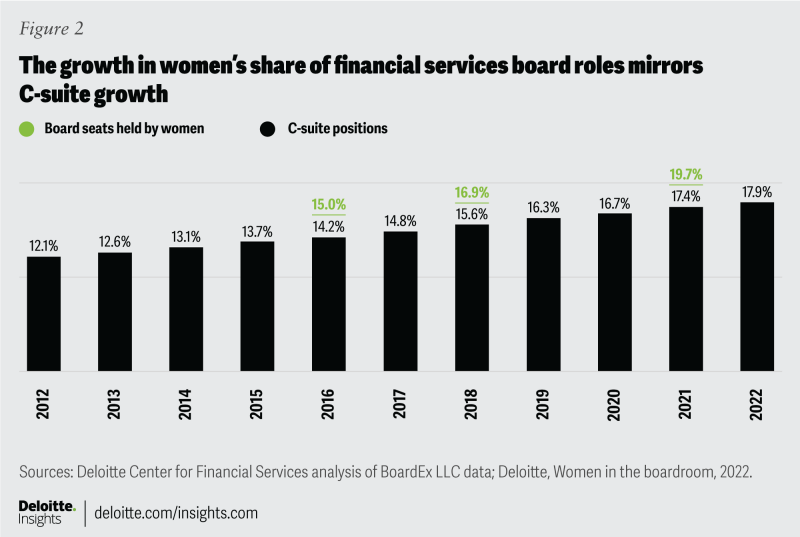Collect more data
Having a complete data picture can help organizations make informed decisions. But many organizations are only scratching the surface of what they could know: 23% of organizations surveyed in Deloitte’s 2023 Global Human Capital Trends “measure progress regarding diversity commitments through adherence to compliance standards—which may focus on activities instead of the impact of those activities.”5
Comprehensive data collection is an important step in achieving gender equity. However, some European countries prohibit diversity monitoring.6 Gathering diversity data and employee feedback through regular pulse checks can highlight blind spots and help identify programs and how they’re working, allowing organizations to concentrate their resources and efforts on where it matters most. Garnering employee trust is often crucial to the data-gathering process. To gain that trust, leaders can focus on being transparent about how the data will be used. This could also garner greater participation.
Assess the data
Assessing diversity data can help set measurable goals and create accountability. Only 32% of the largest US public companies conduct a gender pay-gap analysis. And only 14% of companies report the results, mostly when they are near or at parity.7
Here are three ways to help assess data:
- Analyze diversity data against objectives to provide a clear picture of where the organization stands today.
- Benchmark findings against companies within the industry and at a global or regional level to reveal leading practices and provide meaningful input when setting targets. Starting in 2024, Australian organizations with more than 100 employees will be required to reveal gender pay-gap data, allowing for data benchmarking.8
- Leverage technology to help generate insights faster and minimize unconscious bias.
Report your progress to build trust
Reporting diversity information—both internally and publicly—can help boost transparency and enhance trust.9 Yet, 24% of organizations surveyed in Deloitte’s 2023 Global Human Capital Trends study “are not establishing accountability or measuring progress in their equity commitments.”10 And a recent Harvard Business Review study showed that just 28% of companies hold C-suite executives accountable for progress against the organization’s DEI strategy.11
The majority of small- and medium-sized regulated US FSIs have little to no publicly available information on diversity and inclusion. In 2022, the Consumer Financial Protection Bureau (CFPB) conducted an analysis of diversity and inclusion within financial services, where it found that 68% of 270 regulated FSIs have made little to no diversity and inclusion information available to the public.12When reporting, here are some practices financial services firm leaders can consider:
- Report progress on diversity goals, both internally (to the board and workforce) and externally. Making a public commitment can perhaps increase accountability and bolster DEI advancement.
- Communicate clear metrics for success within the organization to create a more equitable environment.
- Include measurable DEI goals, recruiting, advancement and retention efforts, pay-gap information, and strategies to close diversity gaps.
- Focus on outcomes achieved rather than just measuring activities and effort.
Engage with stakeholders to demonstrate commitment
FSIs should engage within and outside the organization to achieve and show commitment to gender diversity. Ninety-two percent of respondents from Deloitte’s Women @ Work 2023: A Global Outlook believe their organization is not taking concrete steps to fulfill its commitment to gender diversity.13
Leaders can foster engagement, improve their reach of the desired talent pool, and help showcase organizational commitment by:
- Encouraging allyship and sponsorship opportunities;
- Linking performance expectations and measurement to DEI goals;
- Creating opportunities to network, including building and supporting women networks;
- Investing in succession planning; and
- Deploying a systems-based view of how businesses can activate equitable outcomes within and outside an organization.14
FSI leaders have an opportunity to play a pivotal role in helping create a more equitable world. Taking these actions now, at the organizational level, could collectively change the trajectory of women’s share in financial services firm leadership around the world. It could even make achieving gender equity a goal that’s truly within reach.
About our research
We studied historical data from 1998–2022 and forecast growth by region and roles through 2031. This research includes more than 68,000 financial services institutions (FSIs) across nearly 200 countries and territories representing:
- Banking and capital markets
- Payments
- Insurance
- Investment management (private equity, hedge funds, mutual funds)
- Commercial real estate
Our methodologies
- Quantitative analyses: The quantitative analyses reported are based on the Deloitte Center for Financial Services’ proprietary analysis and custom segmentation of financial services institutions’ data from BoardEx LLC from 1998 through December 31, 2022. Where used throughout the report, “financial services” or “FSIs” denote banking, capital markets, commercial real estate, insurance, investment management, and payments provider firms industry segments.
- Forecast methodology: The 2023–2031 projections for women’s share of C-suite roles, senior-leadership roles, and next-generation roles employed the following prediction methodology: The percentage of women for each role category from 1998 to 2022 was considered for modeling purposes. The final models selected for prediction were time-series models that used the Autoregressive Integrated Moving Average model. The data was split into train and test in the proportion of 80–20. Then a grid-search algorithm was applied to arrive at the best-possible model. Diagnostic checks of the selected model were performed and found to be stable for the in-sample data. Out-of-sample predictions were made for the year from 2023 to 2031. Slight recent downward trends are due to our modeling approach, which favors more recent data changes over longer-term trends. In addition, workforce challenges, including pandemic-related transitions, over recent years are possible contributors to several downward trends reflected in the forecast.
- The multiplier effect: A cross-sectional association analysis was conducted at the organizational level to determine the multiplier effect. We used linear regression to quantify the multiplier effect, which effectively reveals x fold change in senior leadership for each additional woman added to the C-suite. As observed in several regions, if a linear correlation does not exist, the multiplier effect is not statistically relevant, and is deemed “not applicable” for a particular region at this time.






















